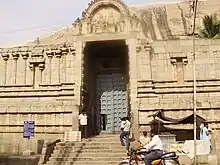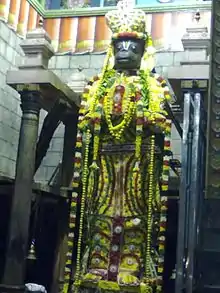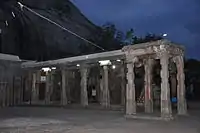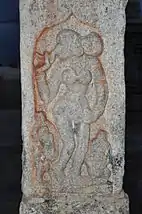Narasimhaswamy Temple, Namakkal
Narasimhaswamy temple in Namakkal, a town in Namakkal district in the South Indian state of Tamil Nadu, is dedicated to the Hindu god Narasimha, an avatar of Vishnu. Constructed in the Dravidian style of architecture and Rock-cut architecture, the temple is located in the Salem - Namakkal- Trichy Road. The legend of the temple is associated with Narasimha, an avatar of Hindu god Vishnu appearing for Lakshmi, his consort, and Hanuman. Based on the architectural features, historians believe that the temple was built during the 8th century.
| Narasimhaswamy Temple | |
|---|---|
 Image of the temple entrance with Namakkal Fort in the background | |
| Religion | |
| Affiliation | Hinduism |
| District | Namakkal |
| Deity | Narasimhaswamy(Vishnu) Namagiri (Lakshmi) |
| Features |
|
| Location | |
| Location | Namakkal |
| State | Tamil Nadu |
| Country | India |
 Location in Tamil Nadu | |
| Geographic coordinates | 11°13′20″N 78°09′51″E |
| Architecture | |
| Type | Dravidian architecture, Rock-cut architecture |
The temple has a pillared hall leading to the sanctum, which has rock-cut architecture. The temple is open from 7:00 am – 1:00 pm and 4:30 - 8:00 pm. Four daily rituals and many yearly festivals are held at the temple, of which fifteen-day Panguni Uthiram festival celebrated during the Tamil month of Panguni (March - April) when the image of presiding deities are taken around the streets of the temple, being the most prominent. The temple is maintained and administered by the Hindu Religious and Endowment Board of the Government of Tamil Nadu.
Legend
As per Hindu legend, Hiranyakasipu, a demon king, was troubling the Devas (celestial deities) as he got a boon from Brahma that no human can kill him, neither could he be killed in morning, noon or night nor in air, water or ground. His son Prahlada was an ardent devotee of Vishnu, garnering the hate of his father. Hiranyakasipu tried to slay Prahalada at various times, just to be saved by the divine grace of Vishnu. During the last heated argument between the two, Hiranyakasipu was asking if Vishnu was present everywhere and went on to break a pillar with his weapon. Vishnu took the avatar of Narasimha and came out of the opening in the pillar. Narasimha was a half-human with a lion face and slayed Hiranyakasipu on an evening time in a doorway, which was neither land nor air.[1][2]
Ages past by, when Lakshmi, the consort of Vishnu was doing penance at this place, seeking his boons. Hanuman (locally called Anjaneyar) was carrying an image made of Saligrama and Lakshmi requested him to help her with a view of Vishnu in the form of Narasimha. Hanuman entrusted the saligrama to her and requested her to hold it until he returns. Lakshmi could not bear the weight and placed the image at this place, which grew into a mount before Hanuman could return. Narasimha appeared before both of them and set his abode at this place.[2]
History
The temple is believed to be built during the 8th century by the Pandya kings in Rock-cut architecture.[3] Historian Soundara Rajan places the date to a pre-Varagunan I (800–830) era on the 8th century.[4] Based on the palaeography and Rock-cut architecture, P.R. Srinivasan has placed it at 8th century. Most of the historians have compared the temples with similar architectural elements found in Badami Caves (6th century) and a possible influence. Some historians have argued that the Azhwars during the Bhakti tradition have discarded Rock-cut images and hence no mention is found in the Nalayira Divya Prabandham about this temple. But the argument is disproved by other historians who have quoted rock-cut temples like Thirumeyyam in Pudukottai district and Ninra Narayana Perumal temple in Virudhunagar district finding mention in the canon.[5] The records of the details of the inscriptions are found in the Annual report of Epigraphy -1961. There are no inscriptions in the temple, but an undated inscription in the Ranganatha temple, which is on the upper cave in the hill. Historians believe it is possible that both the temples were built during the same period.[6]
Architecture

The temple is located along Namakkal-Salem road in Namakkal town, Namakkal district in Tamil Nadu.[7] The temple carved out of an imposing hill, is located in the downhill of the Namakkal Fort, on the western flank of the hill. [3] The temple has a flat gateway tower and a second entrance, also with a flat gateway leading to the pillared halls. The main sanctum sanctorum houses the image of Lord Narasimha in sitting posture, called Asanamurthi with two images under his feet.[8] The sanctum is rock-cut and square in shape with a black background.[5] The sanctum has three sculpted cells, two pillars and a verandah in front of it. The image of Narasimhar is treated as a Yogasana image, with the images under his feet seen to be the Sun and the Moon. It is not called a Bhogasana as the consorts on either side of him are absent. He has Shiva and Brahma on his either sides and he is sported with two hands holding the conch and the chakra. There is a panel depicting the narrative of Varaha avatar of Vishnu, who takes water from Bali and later grows big as Trivikrama to submerge Bali under his feet as per the Skanda Purana. Historians consider this as a deviation from the monoscenic sculptures in temples of Kanchipuram and Mahabalipuram.[9]
The temple has other sculptural relief on the walls of the temple depicting Trivikrama, Narasimha slaying Hiranyakasipu and Ananta sayana Vishnu.[3] The temple tank, Kamalalayam, is located outside the temple.[10] There are similar rock-cut images in the temple halfway up the Namakkal Fort.[3] Of note, it was in front of Namagiri Narashimhar that Saint Purandaradasa composed his famous song "Simha Rupanada Sri Hari, Namagirishane".
The temple complex houses two other sanctums. These sanctums house Namagiri Tayar and Sri Lakshmi Narayana.
Goddess Namagiri Lakshmi fondly called as Namagiri Tayar was the family Goddess of the renowned Mathematician Srinivasa Ramanujan. Ramanujan credited his acumen to his family goddess, Mahalakshmi of Namakkal. He looked to her for inspiration in his work, and claimed to dream of blood drops that symbolised her male consort, Narasimha, after which he would receive visions of scrolls of complex mathematical content unfolding before his eyes. He often said, "An equation for me has no meaning, unless it represents a thought of God."
There are number of sacred bathing places or thirthams in hollows in the sides of the rock and the largest of them is called "Kamalalayam" which is sacred to Lakshmi.
Festival and religious practises

The temple priests perform the pooja (rituals) during festivals and on a daily basis. The temple rituals are performed four times a day: Kalasandhi at 7:00 a.m., Uchikala poojai at 12:30 p.m., Sayarakshai at 4:30 p.m., and Arthajama Pooja at 7:45 p.m.Each ritual has three steps: alangaram (decoration), neivethanam (food offering) and deepa aradanai (waving of lamps) for the presiding deities. There are weekly, monthly and fortnightly rituals performed in the temple. The temple is open from 7:00 am – 1:00 pm and 4:30 - 8:00 pm and The Great Hanuman Temple is open Morning 6.30 am to 1.00 pm. and Evening 4.30 pm to 9.00 pm. on all days except during festive occasions when it has extended timings.[11] The major festivals of the temple is the fifteen day Panguni Uthiram festival celebrated during the Tamil month of Panguni (March - April) when the image of presiding deities are taken around the streets of the temple in a temple chariot. The sacred marriage of the presiding deity is also performed during the function.[12] Other festivals of the temple include Chittirai Tamil New year, Vaigasi Visagam, Telugu New Year, Avani Pavitrotsavam, Narasimhar Jayanthi, Vaikunta Ekadasi and Thai Pongal during various months of the year.[2][13] In modern times, the Namakkal district administration has identified the temple as one of the prominent tourist attractions in the district.[14] The temple is maintained and administered by the Hindu Religious and Endowment Board of the Government of Tamil Nadu.[2]
References
- Anantharaman, Ambujam (2006). Temples of South India. East West Books (Madras). p. 149. ISBN 978-81-88661-42-8.
- "Sri Anjaneyar temple". Dinamalar. 2011. Retrieved 4 November 2015.
- Michell, George (2013). Southern India: A Guide to Monuments Sites & Museums. Roli Books Private Limited. pp. 398–99. ISBN 9788174369031.
- K.V., Soundara Rajan (1998). Rock-cut temple styles: early Pandyan art and the Ellora shrines. Somaiya Publications. p. 59. ISBN 9788170392187.
- V.G., Rajan (December 1999). "Nr̥siṁha Cave Temple at Nāmakkal: Its Iconographical Significance". East and West. Istituto Italiano per l'Africa e l'Oriente (IsIAO). 49 (1/4): 189–194. JSTOR 29757426.
- P.R., Srinivasan (1961). "Sculptures in the Two Rock-Cut Vaiṣṇava Cave Temples of Nāmakkal". Artibus Asiae. Artibus Asiae Publishers. 24 (2): 107–116. JSTOR 3249275.
- India. Office of the Registrar General (1965). Census of India, 1961: Madras Volume 9, Issue 1 of Census of India, 1961, India. Office of the Registrar General. Manager of Publications.
- Monkeys, Motorcycles, and Misadventures. Leadstart Publishing PvtLtd. 2015. p. 65. ISBN 9789352013777.
- Verma, Archana (2012). Temple Imagery from Early Mediaeval Peninsular India. Ashgate Publishing. ISBN 9781409430292.
- Goyal, Ashutosh (2014). RBS Visitors Guide INDIA - Tamil Nadu: Tamil Nadu Travel Guide. Data And Expo India Pvt Ltd. pp. 455–6. ISBN 9789380844817.
- "Temple timings". Narasimhaswamy Anjaneyar Temple administration. 2015. Retrieved 28 November 2015.
- V., Meena (1974). Temples in South India (1st ed.). Kanniyakumari: Harikumar Arts. p. 40.
- "Temple festivals". Narasimhaswamy Anjaneyar Temple administration. 2015. Retrieved 28 November 2015.
- "Tourist places". Namakkal district administration, Government of Tamil Nadu. 2011. Retrieved 26 November 2015.
External links
| Wikimedia Commons has media related to Sri Narasimha Swamy Temple of Namakkal. |








